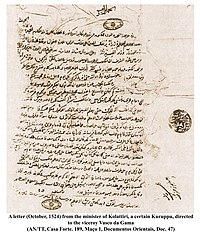Kolathiri: Difference between revisions
Undid revision 1163839480 by 2603:6010:C7F0:8780:61E5:CFA4:31DE:488B (talk) |
Caste promotion,not sourced Tags: references removed Mobile edit Mobile web edit |
||
| Line 20: | Line 20: | ||
| title= Madras District Gazetteers Malabar (Volume-I) | publisher=Madras Government Press |
| title= Madras District Gazetteers Malabar (Volume-I) | publisher=Madras Government Press |
||
| url= https://archive.org/details/in.ernet.dli.2015.358941/mode/2up |
| url= https://archive.org/details/in.ernet.dli.2015.358941/mode/2up |
||
}}</ref> in foreign accounts) was the title by which the senior-most male along the matrilineal line of the [[Mushika Kingdom|Mushika]] or '''Kolathunādu Royal Family''' (Kolaswarũpam) based at [[North Malabar]] region was styled.<ref name = "Kol1">Duarte Barbosa, The Book of Duarte Barbosa: An Account of the Countries Bordering on the Indian Ocean and their Inhabitants, II, ed.M. L Dames (repr., London: Hakluyt Society, 1921)</ref><ref name = "Kol2">The Dutch in Malabar: Selection from the Records of the Madras Government, No. 13 (Madras: Printed by the Superintendent, Government Press, 1911), 143.</ref> It's a descendent of the [[Mushika dynasty]] |
}}</ref> in foreign accounts) was the title by which the senior-most male along the matrilineal line of the [[Mushika Kingdom|Mushika]] or '''Kolathunādu Royal Family''' (Kolaswarũpam) based at [[North Malabar]] region was styled.<ref name = "Kol1">Duarte Barbosa, The Book of Duarte Barbosa: An Account of the Countries Bordering on the Indian Ocean and their Inhabitants, II, ed.M. L Dames (repr., London: Hakluyt Society, 1921)</ref><ref name = "Kol2">The Dutch in Malabar: Selection from the Records of the Madras Government, No. 13 (Madras: Printed by the Superintendent, Government Press, 1911), 143.</ref> It's a descendent of the [[Mushika dynasty]]. |
||
==Cultural depictions== |
==Cultural depictions== |
||
Revision as of 18:31, 30 November 2023
Kolathiri or Kolathiri Rājā (King of Kolathunādu[1] or King of Cannanore[1][2][3][4][5] in foreign accounts) was the title by which the senior-most male along the matrilineal line of the Mushika or Kolathunādu Royal Family (Kolaswarũpam) based at North Malabar region was styled.[6][7] It's a descendent of the Mushika dynasty.
Cultural depictions

"Kolathiri" appears as a character in a Malayalam film titled Urumi. The film was loosely based on Portuguese interference in north Kerala and the misdeeds committed by Vasco da Gama, who was hailed as a hero in the west but was actually a cold-hearted tyrant to other lands of the spice route; his entry into Kerala politics and manipulating the kingpins and a young Indian who tries to kill Vasco da Gama. The movie was released on 31 March 2011.
References
- ^ a b A. Shreedhara Menon (2007), A brief History of Kerala, DC Books, Kottayam
- ^ S. Muhammad Hussain Nainar (1942). Tuhfat-al-Mujahidin: An Historical Work in The Arabic Language. University of Madras.
- ^ K. V. Krishna Iyer (1938). Zamorins of Calicut: From the earliest times to AD 1806. Norman Printing Bureau, Kozhikode.
- ^ William Logan (1887). Malabar Manual (Volume-I). Madras Government Press.
- ^ Charles Alexander Innes (1908). Madras District Gazetteers Malabar (Volume-I). Madras Government Press.
- ^ Duarte Barbosa, The Book of Duarte Barbosa: An Account of the Countries Bordering on the Indian Ocean and their Inhabitants, II, ed.M. L Dames (repr., London: Hakluyt Society, 1921)
- ^ The Dutch in Malabar: Selection from the Records of the Madras Government, No. 13 (Madras: Printed by the Superintendent, Government Press, 1911), 143.
